
This item discussing the legal implications surrounding Fair Use law in education. For educators.
- Subject:
- English Language Arts
- Material Type:
- Module
- Author:
- Ellen Feig
- Date Added:
- 03/10/2017

This item discussing the legal implications surrounding Fair Use law in education. For educators.
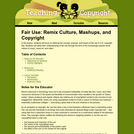
In this lesson, students will focus on defining the concept, purpose, and impact of fair use in U.S. copyright law. Students will refine their understanding of fair use through the lens of the increasingly popular remix culture of music, visual art, and video.

This is a video about Fair Use Rights created by Sara Benson, copyright librarian at the University of Illinois Library. This brief video explains fair use, risk assessment, and some key fair use cases.
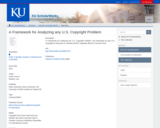
This easy to use framework walks students through how to analyze any United States copyright problem. This tool could be used to learn copyright law when applying it to given real or hypothetical situations.
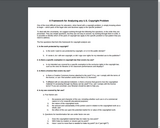
One of the most difficult issues for educators, when faced with a copyright problem, is simply knowing where
to begin -- which parts of the legal rules and doctrines apply to the specific problem? To deal with this uncertainty, we suggest working through the following five questions, in the order they are presented. They are simple questions, but they are not easy to answer; by working through them in order, it is possible to identify which of the parts of copyright law apply to the specific problem or fact pattern that you need to address.
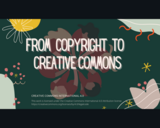
A brief overview of the history of copyright laws and why the Creative Commons was right on time!
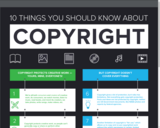
FREE infographic you can download and print to distribute or share with your school. If you would like
printed glossy 11×17 posters, we would be happy to mail to your schools, free of charge. Send a request by emailing: info@copyrightandcreativity.org.
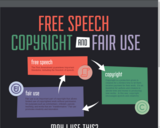
FREE Infographic for educational use with students or staff. You may print them yourself to display OR we would be happy to mail you glossy 11×17 posters, free of charge. Send a request by emailing: info@copyrightandcreativity.org.

This tool is designed to help you locate openly licensed materials to add to your OER. We'll also review how to incorporate content that is not openly licensed (copyrighted) through the principles of fair use.

This course is an introduction to copyright law and American law in general. Topics covered include: structure of federal law; basics of legal research; legal citations; how to use LexisNexis®; the 1976 Copyright Act; copyright as applied to music, computers, broadcasting, and education; fair use; Napster®, Grokster®, and Peer-to-Peer file-sharing; Library Access to Music Project; The 1998 Digital Millennium Copyright Act; DVDs and encryption; software licensing; the GNU® General Public License and free software.

This course is designed to offer an advanced introduction to key legal issues that arise in the area of property and land-use in American law, with a comparative focus on the laws of India and South Africa. The focus of the course is not on law itself, but on the policy implications of various rules, doctrines and practices which are covered in great detail. Legal rules regulating property are among the most fundamental to American, and most other, economies and societies. The main focus is on American property and land use law due to its prominence in international development policy and practice as a model, though substantial comparative legal materials are also introduced from selected non-western countries such as India and South Africa.
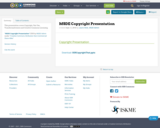
This presentation covers Copyright, Fair Use, Transformativeness and Creative Commons Licensing.

This resource equips Nebraska educators with training and support to author high-quality open educational resources for CTE programs. Our goal is a hub of reliable and attractive materials on relevant program topics that are easily discoverable within aligned Nebraska Career Pathways. Section One prepares OER authors by setting us up on OER Commons and metatagging for Nebraska CTE. Section Two compiles resources to clarify Fair and Transformative Use of copyrighted work. Section Three links to an award-winning and comprehensive OER training.

This is an edited volume of chapters from copyright experts around the globe explaining complex copyright issues in a clear, concise way. The majority of the chapters are licensed CC-BY.

This is an edited volume of chapters from copyright experts around the globe explaining complex copyright issues in a clear, concise way. The majority of the chapters are licensed CC-BY.

In this one hour webinar, we’ll discuss best practices and practical strategies for deciding when and how much of a copyrighted work you can include under fair use. After the workshop, educators will be able to enrich their course materials with photos, video clips, newspaper articles, and more. Better yet, they will know how to share them with a larger audience.
Bookmarks
Introduction: 0:00
Mini Intro to Copyright and Creative Commons: 9:33
Tools & Resources: 15:45
Language Specific Examples: 26:48
Webinar Materials
- Webinar Slides: https://docs.google.com/presentation/...
- Overcoming Copyright Fear Worksheet: Fair Use: https://docs.google.com/document/d/1z...
- Overcoming Copyright Fears Questions Document: https://docs.google.com/document/d/1_...
Connect with the Pathways Project on Social Media:
- Instagram: https://www.instagram.com/boisestatep...
- LinkedIN: https://www.linkedin.com/groups/9178362/
- Twitter: https://twitter.com/PathwaysBSU
Overcoming Copyright Fears Webinar by The Pathways Project is licensed under a Creative Commons Attribution-NonCommercial-ShareAlike 4.0 International License.
http://creativecommons.org/licenses/b...
Acknowledgement
The Pathways Project is grateful to provide this professional development opportunity thanks to a recently awarded National Endowment for the Humanities Digital Humanities Advancement Grant.
About the National Endowment for the Humanities
Created in 1965 as an independent federal agency, the National Endowment for the Humanities supports research and learning in history, literature, philosophy, and other areas of the humanities by funding selected, peer-reviewed proposals from around the nation. Additional information about the National Endowment for the Humanities and its grant programs is available at: http://www.neh.gov

This course is an intensive introduction to the U.S. law of intellectual property with major emphasis on patents, including what can be patented, the process of patent application, and the remedies for patent infringement.
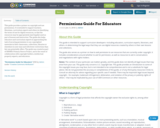
This guide provides a primer on copyright and use permissions. It is intended to support teachers, librarians, curriculum experts and others in identifying the terms of use for digital resources, so that the resources may be appropriately (and legally) used as part of lessons and instruction. The guide also helps educators and curriculum experts in approaching the task of securing permission to use copyrighted materials in their classrooms, collections, libraries or elsewhere in new ways and with fewer restrictions than fair use potentially offers. The guide was created as part of ISKME's Primary Source Project, and is the result of collaboration with copyright holders, intellectual property experts, and educators.
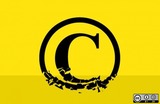
This guide provides a primer on copyright and use permissions. It is intended to support teachers, librarians, curriculum experts and others in identifying the terms of use for digital resources, so that the resources may be appropriately (and legally) used as part of lessons and instruction. The guide also helps educators and curriculum experts in approaching the task of securing permission to use copyrighted materials in their classrooms, collections, libraries or elsewhere in new ways and with fewer restrictions than fair use potentially offers. The guide was created as part of ISKME's Primary Source Project, and is the result of collaboration with copyright holders, intellectual property experts, and educators.* "Copyright license choice" by opensource.com is licensed under CC BY-SA 2.0.
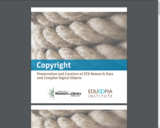
This guide focuses specifically on some of the decisions you may need to make regarding the materials you have created or used in your research process, including drawings and photographs, tables and charts, lab notes and datasets, interviews and newscasts, software and digital artworks. It describes in non-legal language the basics of a few important terms, including “fair use,” “public domain,” “Creative Commons,” and “patent” as they may apply to these materials. Failure to consider the implications of different copyright and patent approaches for your own work can limit the impact of your work. Failure to adequately review, vet, and seek permission to use others’ work can, in a worst-case scenario, prevent your work from getting published or (in rare cases) lead to legal actions.